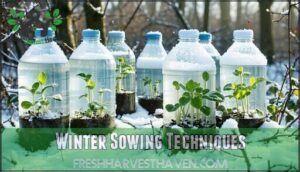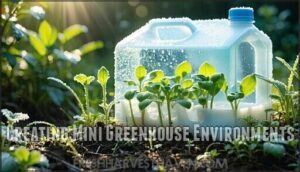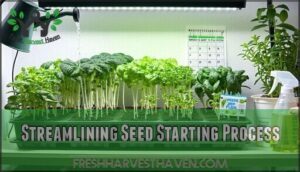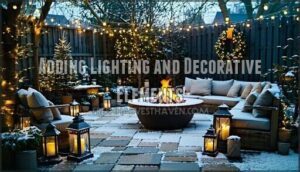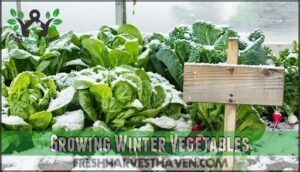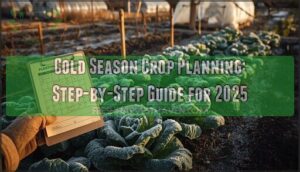This site is supported by our readers. We may earn a commission, at no cost to you, if you purchase through links.
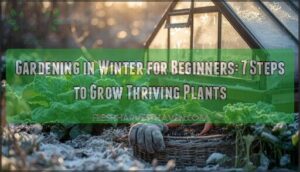
You can grow cold-hardy vegetables like kale, spinach, and carrots right through freezing temperatures – they actually taste sweeter after frost hits.
Start by choosing plants that laugh at cold weather, then use simple protection like row covers or cold frames to extend your harvest season.
Winter sowing seeds directly in containers outdoors gives you stronger seedlings come spring.
The secret isn’t fighting winter’s chill, but working with it to create a thriving garden when others think growing season’s over.
Master these fundamentals and discover techniques that transform frozen ground into productive space, allowing you to grow a variety of plants and enjoy the benefits of year-round growing and a longer harvest season.
Table Of Contents
- Key Takeaways
- Winter Gardening Basics
- Starting Seeds in Winter
- Winter Garden Design
- Winter Garden Maintenance
- Growing Winter Vegetables
- Frequently Asked Questions (FAQs)
- When should you start your winter garden?
- What do you plant in your garden in the winter time?
- What’s the easiest vegetable to grow in winter?
- What vegetables go in the winter garden?
- How do you start a garden in the winter?
- Is gardening in winter a good idea?
- What makes a beautiful winter garden?
- What vegetables can you grow in winter?
- What is a Winter Garden?
- Why do you need a Winter Garden?
- Conclusion
Key Takeaways
- You’ll grow fresh vegetables year-round by choosing cold-hardy plants like kale, spinach, and carrots that actually taste sweeter after frost hits
- Start your winter garden in early fall, 6-8 weeks before first frost, to give plants time to establish before temperatures drop
- Use simple protection methods like row covers, cold frames, and thick mulch layers to create warm microclimates that extend your harvest season
- Try winter sowing seeds in milk jugs outdoors – this natural cold stratification produces stronger seedlings ready to thrive come spring
Winter Gardening Basics
You can keep your garden productive through winter by learning which plants thrive in cold weather and using simple protection methods.
Winter gardening isn’t just about surviving the cold—it’s about working with cooler temperatures to grow fresh vegetables and herbs when most people think gardening season is over.
Extending Growing Season
With thoughtful planning, you can extend your growing season well beyond summer’s end. Season extension techniques transform your beginner winter garden into a productive year-round space.
- Install cold frames for heat retention and frost protection plants
- Create microclimates by positioning tender plants near south-facing walls
- Practice succession planting every 2-3 weeks for continuous harvests
- Apply thick mulch layers to insulate soil and protect root systems
- Use row covers and hoop tunnels during unexpected cold snaps
These winter gardening tips help cold weather plants thrive through crop rotation cycles.
Choosing Cold Hardy Plants
Selecting cold hardy plants starts with understanding your Hardiness Zones—these numbers tell you which plants survive your winter temperatures.
Frost Tolerance varies by Plant Families, so kale and spinach handle cold better than tomatoes.
Visit Local Nurseries for region-specific advice on cold weather plants. Microclimates Matter too—sheltered spots near buildings stay warmer.
Choose native varieties first; they’re naturally adapted to your area’s conditions and make beginner winter garden success easier. These plants often establish faster in spring, yielding earlier harvests compared to others, and are considered winter hardy plants.
Planting Techniques for Winter
Now that you’ve picked your cold-hardy champions, it’s time to get them in the ground right.
Soil preparation starts with loosening compacted earth and mixing in compost for better drainage. Direct winter sowing works great for hardy seeds like spinach and radishes.
Practice succession planting by sowing new crops every two weeks for continuous harvests. Focus on root protection by planting slightly deeper than summer depths.
For ideal growth, consider supplementing with LED grow lights. Indoor transplanting requires proper hardening off—gradually expose seedlings to outdoor conditions over a week before transplanting your winter vegetable garden.
Utilizing Cold Frames and Mulch
Cold frames act like mini-greenhouses, boosting temperatures 5-10°F above outside air for extended harvests.
Build your Cold Frame Design using reclaimed windows over wooden boxes, positioning them south-facing for maximum warmth.
Layer Mulch Types like straw or shredded leaves 2-4 inches thick around plants for soil insulation and Moisture Control.
They’re also useful for early seed starting, especially for cold-weather crops.
This combination creates effective frost protection while preventing Pest Prevention issues during winter months.
Starting Seeds in Winter
Winter seed starting transforms cold months into productive growing time, letting you get ahead on your spring garden while most gardeners wait.
You’ll master techniques like winter sowing and creating mini greenhouse environments that use cold temperatures to your advantage, producing stronger seedlings ready to thrive when warmer weather arrives, which is a key part of productive growing time.
Winter Sowing Techniques
Winter sowing transforms Direct Sowing into a hands-off technique that works with nature’s timeline. You’ll use the Jug Method with Milk Containers and other clear plastic containers, creating perfect mini-greenhouses for hardy seeds. Simply drill drainage holes, add moistened seed starting mix, and let winter’s freeze-thaw cycles handle cold weather gardening naturally.
Snow Protection actually benefits your containers by providing insulation and consistent moisture.
Winter sowing mimics nature’s rhythms, turning simple containers into thriving hubs for hardy seeds with built-in cold stratification.
Seed Viability improves through this natural stratification process, giving you stronger seedlings come spring.
- Choose perennials like milkweed, coneflower, and Black-eyed Susan for best results
- Start containers in January or February for ideal winter garden planting timing
- Label everything clearly—you’ll forget which seeds went where by spring thaw
Creating Mini Greenhouse Environments
Transform repurposed containers like milk jugs into effective DIY Greenhouse solutions by cutting ventilation holes and ensuring proper drainage.
These garden protection structures create ideal microclimates for seed starting while naturally hardening seedlings through temperature fluctuations.
Position your mini structures in sunny locations to maximize warmth without additional heating options.
Consider kits for easy setup to simplify the building process.
Smart material selection and ventilation needs prevent fungal issues while supporting healthy germination in your winter gardening setup.
Promoting Germination in Cold Temperatures
Four key techniques help you achieve successful seed priming during winter gardening.
Start by maintaining proper humidity control through plastic milk jugs with holes for ventilation.
Soil warming occurs naturally when containers receive direct sunlight, eliminating the need for expensive heat mats.
Light requirements vary by seed type, but most winter varieties germinate well with natural daylight.
Monitor moisture levels carefully—seeds need consistent dampness without becoming waterlogged for ideal frost protection techniques.
Streamlining Seed Starting Process
Organized seed starting makes winter gardening manageable for beginners.
Follow these steps:
- Seedling Heat Mats – Place under containers to maintain consistent soil temperature
- Grow Light Setup – Position 6 inches above seeds for adequate illumination
- Optimized Watering – Check moisture daily using finger test method
- Germination Timing – Start seeds 6-8 weeks before last frost date
- Early Fertilization – Apply diluted liquid fertilizer once true leaves appear
This streamlined approach transforms indoor winter gardening into an efficient system; consider using cold stratification methods for ideal germination.
Winter Garden Design
Your winter garden’s design sets the stage for months of visual appeal and productive harvests when other gardens lie dormant.
Smart placement of cold-hardy plants, protective structures, and thoughtful layout choices transform your outdoor space into a thriving winter wonderland that defies the season’s challenges, creating a winter wonderland.
Structuring and Forming Winter Gardens
Creating a solid garden layout starts with understanding your space’s natural flow.
Evergreen shrubs and deciduous trees provide backbone structure, while wind protection through strategic hedging shields delicate plants.
Raised beds offer better drainage and organization for your winter garden design.
Position cold frames near your home for easy access during early planting seasons.
This winter garden planning creates visual appeal and practical functionality year-round.
Soil preparation should include adding compost or manure in late fall.
Selecting Plants for Winter Interest
Your winter garden needs plants that shine when everything else fades. Choose evergreen structure like boxwood for backbone, then add winter berries from holly shrubs. Fragrant blooms like hellebores provide unexpected delights, while textured bark from red twig dogwood creates stunning contrast against snow.
Winter gardens reward patience with unexpected beauty when everything else sleeps.
- Foliage color champions include bergenia with bronze winter hues
- Best winter plants feature mahonia’s bright yellow flowers
- Cold hardy plants like witch hazel bloom through freezing temperatures
- Winter flower garden stars include cyclamen and Christmas roses
Incorporating Containers and Architectural Elements
Container materials like stone and metal planters create durable winter foundations that withstand freezing temperatures.
Vertical structures such as trellises and obelisks add height while maximizing space optimization in compact areas.
Position containers to create microclimates that protect tender plants from harsh winds.
Aesthetic integration works best when you group containers by size and texture, creating visual rhythm throughout your winter garden design.
Adding Lighting and Decorative Elements
Transform your winter garden into an enchanting space with thoughtful lighting and decorative touches.
Solar lanterns illuminate pathways while string lights create magical ambiance around seating areas.
A fire pit or chiminea becomes your garden’s warm heart on frosty evenings.
Strategic garden lighting enhances both safety and beauty through these elements:
- Ambient lighting from LED strips highlights architectural features and creates cozy gathering spots
- Reflective surfaces like metallic planters or mirrors amplify existing light sources
- Color accents through colored bulbs or lanterns add personality to neutral winter landscapes
- Garden art positioned near light sources becomes dramatic focal points after dark
Festive decor like evergreen wreaths brings seasonal charm without overwhelming your space’s natural beauty.
Consider specialized outdoor options to withstand the elements.
Winter Garden Maintenance
Once your winter garden is established, you’ll need consistent care to keep plants healthy and productive through the cold months.
Regular maintenance tasks like harvesting at the right time, protecting against frost damage, and preparing soil for spring will guarantee your garden thrives all season long, with tasks like these being part of the regular maintenance.
Harvesting Winter Vegetables
Timing your winter harvest matters more than you might think.
Harvest timing depends on each crop’s cold tolerance – kale and Brussels sprouts actually taste sweeter after light frosts, while carrots need digging before ground freezes solid.
Tool selection makes a difference; use sharp spades for root winter vegetables and clean scissors for leafy greens.
Storage methods vary by crop – leave root vegetables in mulched ground for natural preservation, or store harvested produce in cool, humid conditions.
Regular harvesting keeps plants producing longer, extending harvests well into winter with proper winter gardening tips for beginners.
Using row covers effectively can also shield plants from frost and pests.
Protecting Plants From Frost and Disease
After harvesting your winter crops, you’ll need to shield remaining plants from harsh conditions.
Winter garden protection requires proactive frost prevention and disease control strategies.
Here’s your winter plant care plan:
- Cover plants with breathable row covers – Use frost fabric instead of plastic to prevent condensation buildup
- Apply 2-4 inch winter mulching layer – Keep mulch away from plant stems to avoid rot
- Ensure proper air circulation – Space plants adequately to reduce fungal disease risks
- Remove infected foliage immediately – Practice disease management through regular inspections and cleanup
- Water soil before frost events – Moist ground releases heat overnight, providing natural frost protection
Composting and Soil Preparation
Now that you’ve safeguarded your plants, focus on building rich, healthy soil for next season.
Composting kitchen scraps and fallen leaves creates nutrient-dense compost types perfect for winter preparation.
Mix in soil amendments like aged manure to boost fertility.
Apply thick winter mulching with straw or shredded leaves to retain moisture and prevent erosion.
Soil testing reveals pH levels and nutrient gaps, guiding your fertilizing soil strategy for ideal garden soil management.
Pruning and Preparing Plants for Spring
With proper soil care behind you, winter pruning becomes your next priority.
Use sharp pruning tools to cut back perennials and remove dead growth during the dormant season. Clean blades prevent disease spread between plants.
Apply mulch around remaining plants for protection. Following this Spring Pruning Guide and dormant season care routine guarantees healthier growth when early bloom prep begins, making plant division timing easier come spring.
Growing Winter Vegetables
You can successfully grow fresh vegetables throughout winter by choosing cold-hardy varieties and using simple protection methods.
Start with easy crops like spinach, kale, and radishes, then expand to root vegetables as you gain confidence with winter growing techniques.
Choosing Easy to Grow Vegetables
Since beginner-friendly veggies form the foundation of successful winter gardening, focus on these low-maintenance varieties:
- Leafy greens (kale, spinach, Swiss chard) – pest-resistant crops that bounce back from frost damage
- Root vegetables (carrots, radishes, beets) – soil-tolerant plants requiring minimal care once established
- Alliums (garlic, onions) – quick-harvest options planted once and forgotten until spring
- Cold-hardy vegetables (Brussels sprouts, cabbage) – growing vegetables winter becomes effortless with these reliable performers
Planting and Caring for Winter Vegetables
How do you keep winter vegetables thriving when frost threatens and daylight dwindles? Winter garden care starts with timing your planting when soil temperatures hit 45-50°F, giving cold-hardy vegetables their best shot at establishment.
Your watering strategies should shift to deep, weekly sessions rather than frequent light sprinkles, since cool soil retains moisture longer. Pest control becomes essential as slugs and aphids love these conditions—use organic treatments immediately when spotted.
Fertilizing needs are lighter in winter; liquid seaweed fertilizer provides gentle nutrition without pushing excessive growth. Monitor soil health by checking drainage, as waterlogged roots spell disaster.
Position plants strategically to capture maximum sunlight, and remember that harvesting tips include cutting outer leaves first to encourage continued production throughout your growing vegetables winter season.
Extending Harvest Season With Cold Frames
Once you’ve mastered caring for winter vegetables, cold frames become your secret weapon for extending growing season well into the coldest months. These simple structures use passive solar heating to create protective microclimates around your plants.
Cold frame design ranges from basic wooden boxes with old windows to sophisticated models with automatic ventilation strategies. Position frames facing south to capture maximum winter sunlight. Open lids on warm days to prevent overheating and maintain proper airflow for pest control.
Smart crop rotation within frames keeps soil healthy while maximizing space. You’ll harvest fresh greens when neighbors think winter gardening is impossible:
- Fresh salads in January – imagine crisp lettuce while snow covers everything else
- Extended harvests – pick vegetables weeks longer than outdoor gardens
- Protected seedlings – start spring crops early in your cozy cold frame sanctuary
Troubleshooting Common Winter Gardening Issues
Every winter gardener encounters obstacles, but knowing how to tackle them keeps your plants thriving through the coldest months.
frost heaving
Winter garden challenges often stem from timing issues. Plant too late, and you’ll face poor establishment. Harvest delays lead to crop damage from sudden cold snaps.
For effective winter garden pest control, clear debris before snowfall to eliminate overwintering insects. Monitor winter garden soil regularly—nutrient deficiency shows through yellowing leaves, while poor drainage creates root rot conditions.
Frequently Asked Questions (FAQs)
When should you start your winter garden?
Here’s the moment that catches many beginners off guard: you’ll want to start planting your winter garden in early fall, typically 6-8 weeks before your first expected frost date.
What do you plant in your garden in the winter time?
You’ll plant cold-hardy vegetables like kale, spinach, carrots, and Brussels sprouts, plus hardy herbs such as parsley and thyme in your winter garden.
What’s the easiest vegetable to grow in winter?
Like a trusty companion weathering winter’s chill, spinach stands resilient when other vegetables surrender.
You’ll find this leafy hero thrives in cold soil, tolerates frost beautifully, and grows quickly with minimal fuss or special care, making it a reliable choice.
What vegetables go in the winter garden?
You’ll want cold-hardy vegetables like kale, spinach, carrots, beets, radishes, Brussels sprouts, cabbage, broccoli, Swiss chard, parsley, and garlic for successful winter growing.
How do you start a garden in the winter?
While summer gardens rest dormant, winter’s harsh conditions actually create perfect opportunities for dedicated gardeners.
Start by testing your soil and adding compost, then choose cold-hardy vegetables like kale and spinach.
Plant in early fall, install protective structures like cold frames, and guarantee proper drainage for success.
Is gardening in winter a good idea?
Yes, winter gardening’s an excellent idea for beginners.
You’ll enjoy fresh produce year-round, reduce grocery bills, and keep your soil healthy.
Cold-hardy vegetables like kale and spinach actually taste sweeter after frost hits.
What makes a beautiful winter garden?
A winter garden blooms like frost-kissed art through contrast and texture.
You’ll create beauty by combining evergreen structure, colorful cold-hardy plants like kale and pansies, plus protective elements that frame your hardy vegetables in an aesthetically pleasing design, using complete concepts to guide your creation.
What vegetables can you grow in winter?
You can grow cold-hardy vegetables like kale, spinach, Brussels sprouts, carrots, beets, radishes, broccoli, cabbage, and Swiss chard.
Root vegetables store well in cold soil, while leafy greens actually sweeten after frost.
What is a Winter Garden?
A winter garden extends your growing season by cultivating cold-hardy plants during cooler months.
You’ll grow vegetables like kale, spinach, and root crops that actually thrive in lower temperatures, providing fresh produce year-round.
Why do you need a Winter Garden?
You’ll enjoy fresh, homegrown vegetables when grocery stores offer limited winter produce.
Winter gardens reduce food costs, improve soil health, extend your growing season, and provide a rewarding hobby during colder months.
Conclusion
Consider Sarah’s experience: she thought her garden days were over when November arrived, but discovered her spinach and carrots thrived under a simple row cover, providing fresh salads all winter long.
Winter gardening for beginners isn’t about battling the cold—it’s about embracing it. You’ve learned to select frost-tolerant plants, use protective structures, and time your plantings correctly.
These techniques transform your perception of growing seasons entirely. Start with one cold-hardy crop this winter, then expand your knowledge each season. Your garden doesn’t need to sleep when temperatures drop, and neither should your growing ambitions.
- http://depts.washington.edu/uwbg/docs/WinterGardenMap2018.pdf
- https://sites.tufts.edu/pollinators/2019/11/why-you-should-leave-the-leaves-and-give-yourself-a-break-from-yard-work/
- https://extension.unh.edu/blog/2020/11/can-you-compost-winter
- https://www.nrcs.usda.gov/wps/portal/wcc/home/climateSupport/wetlandsClimateTables/growingSeasonDatesLength
- https://planthardiness.ars.usda.gov/

